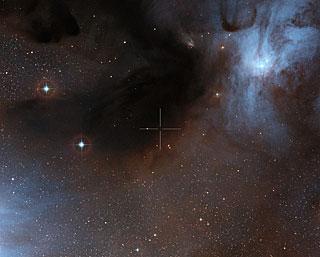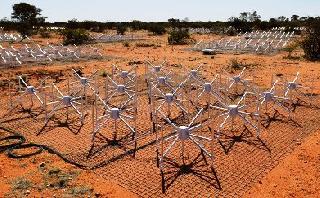
This image shows the brown dwarf ISO-Oph 102, or Rho-Oph 102, in the Rho Ophiuchi star-forming region. Its position is marked by the crosshairs. This visible-light view was created from images forming part of the Digitized Sky Survey 2. Photo: ALMA (ESO/NAOJ/NRAO)/Digitized Sky Survey 2. Acknowledgement: Davide De Martin.
SANTIAGO (AFP): Astronomers are reporting a find that challenges traditional theories as to how rocky planets -- such as Earth -- are formed.
Besides Earth, our solar system has three other rocky planets: Mercury, Venus and Mars. They have a solid surface and core of heavy metals, and differ from planets that are large spinning bodies of gas, like Jupiter or Saturn.
The new findings suggest rocky planets may be even more common in the universe than previously thought. The research was presented on Friday in the Astrophysical Journal of Letters.
The astronomers used a cutting-edge telescope called ALMA, on a mountaintop 5,000 meters high in the remote desert of northern Chile.
They peered out into space at a brown dwarf named ISO-Oph 102. A brown dwarf is an object that is like a star but too small to shine as brightly.
Traditional theory holds that rocky planets form through the random collision of microscopic particles in the disc of material that surrounds a star. The particles, like fine soot, stick together and grow.
Scientists thought the outer reaches of brown dwarves were different. They believed the grains there could not cling together because the discs were too sparse. Also, particles would be moving too fast to stick together after colliding.
But lo and behold, in the disc around ISO-Oph 102, the astronomers found things that, for them at least, were big -- millimeter-sized grains.
"Solid grains of that size shouldn't be able to form in the cold outer regions of a disc around a brown dwarf, but it appears that they do," said Luca Ricci of the California Institute of Technology, who led a team of astronomers based in the United States, Europe and Chile.
"We can't be sure if a whole rocky planet could develop there, or already has, but we're seeing the first steps. So we're going to have to change our assumptions about conditions required for solids to grow."
 Previous Article
Previous Article Next Article
Next Article












The Indian Air Force, in its flight trials evaluation report submitted before the Defence Ministry l..
view articleAn insight into the Medium Multi-Role Combat Aircraft competition...
view articleSky enthusiasts can now spot the International Space Station (ISS) commanded by Indian-American astr..
view article